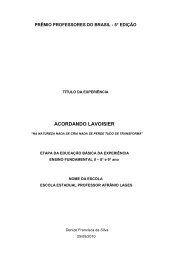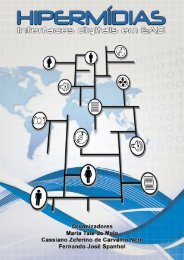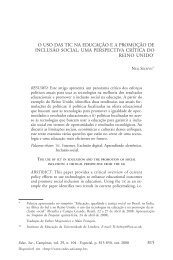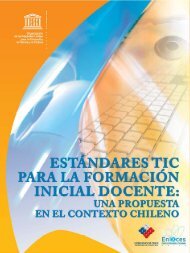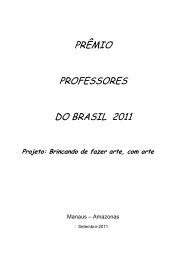BIO-CULTURAL COMMUNITY PROTOCOLS - Portal do Professor
BIO-CULTURAL COMMUNITY PROTOCOLS - Portal do Professor
BIO-CULTURAL COMMUNITY PROTOCOLS - Portal do Professor
Create successful ePaper yourself
Turn your PDF publications into a flip-book with our unique Google optimized e-Paper software.
PART II / CHAPTER 6<br />
5. The Options Provided by BCPs to<br />
Address these Challenges<br />
While integrating communities into PES schemes will remain<br />
complex, the use of BCPs, as described in the context of ABS,<br />
could offer clear support in facilitating the process and<br />
enabling sustainable schemes that positively contribute to<br />
local livelihoods and strengthen their bio-cultural ways of life.<br />
The following section outlines some of the possible benefits<br />
that BCPs offer in the context of PES schemes.<br />
5.1 The BCP Process as a Tool for<br />
Capacity Development<br />
Similar to the ABS context, a BCP in a PES scheme would<br />
serve both as process and outcome. The process would help<br />
with the identification of the community and its different<br />
stakeholders. The development of the BCPs would set out<br />
who is included in the community, which resources and<br />
practices they rely on and other characteristics relevant to<br />
a PES scheme such as the community’s bio-cultural values<br />
concerning land use. The process of engaging community<br />
members in the design of a BCP would also facilitate the<br />
sharing of information about the concepts of PES schemes<br />
and how they could be integrated into en<strong>do</strong>genous<br />
development planning. It would also allow community<br />
members to discuss the nature of individual PES schemes,<br />
their local adaptability and relevance and their accompanying<br />
opportunities and challenges, including how they may<br />
support their bio-cultural ways of life.<br />
5.2 Affirmation of Local<br />
Decision-making Processes<br />
In order to set up a PES scheme, a community has to enter<br />
into a negotiation process with one or more actors, such<br />
as other communities serving as ESS providers, possible<br />
users of ESS or intermediaries. To <strong>do</strong> so, the community<br />
has to decide on who should represent them in such<br />
negotiations, which could be existing representatives,<br />
local leaders who represent the community in other<br />
matters or new representatives. In communities that are<br />
well-organized and already have a history of negotiating<br />
the use of natural resources at the local level, the selection<br />
of such representatives is likely to be fairly easy. In other<br />
cases in which no such process has taken place before,<br />
<strong>BIO</strong>-<strong>CULTURAL</strong> <strong>COMMUNITY</strong> <strong>PROTOCOLS</strong> IN THE<br />
CONTEXT OF PAYMENT FOR ECOSYSTEM SERVICES<br />
the selection of a representative to negotiate on behalf of<br />
the community will be more challenging. Either way, the<br />
process of developing a BCP will be beneficial as it will<br />
confirm existing representatives and give them the authority<br />
to negotiate a PES scheme on behalf of the community,<br />
or it will lead to the selection of a new group of<br />
representatives or committee. Through the BCP process,<br />
the representatives will be given a clear mandate about<br />
how to engage in the negotiations. The protocol itself<br />
will also help outsiders who would like to enter into<br />
negotiations with the community to identify a point of<br />
contact to approach.<br />
5.3 Reducing Transaction Costs through<br />
Prepared Communities<br />
One of the biggest challenges to making PES work is the<br />
high transaction costs associated with setting up and<br />
maintaining a PES scheme. If transaction costs outweigh the<br />
possible gains made by an ESS user for paying an ESS provider<br />
to maintain or improve land use practices, then the whole<br />
PES scheme is redundant. Thus, reducing transaction costs<br />
of setting up and maintaining a scheme is essential.<br />
While BCPs will not be able to prevent all transaction costs,<br />
they have the potential to reduce some of the costs associated<br />
with negotiating with ILCs. First, communities that have<br />
developed BCPs are better prepared for entering into<br />
negotiations with visions of what they want to achieve from<br />
such a scheme. They will have also decided who will represent<br />
them in negotiations and will have given that representative<br />
a clear mandate. Furthermore, building local capacity and<br />
understanding the concept of PES through the BCP process<br />
will further facilitate the efficacy of negotiations. Finally, when<br />
several neighboring communities are integrated into one<br />
PES scheme, the joint formulation of a BCP can help<br />
participating communities collectively align their visions<br />
with respect to the scheme, thus reducing some of the<br />
transaction costs of working with different groups at<br />
the same time.<br />
Other factors associated with the BCP process are likely to<br />
lower transaction costs directly or indirectly.<br />
64





